Day-602
Quiz-summary
0 of 5 questions completed
Questions:
- 1
- 2
- 3
- 4
- 5
Information
DAILY MCQ
You have already completed the quiz before. Hence you can not start it again.
Quiz is loading...
You must sign in or sign up to start the quiz.
You have to finish following quiz, to start this quiz:
Results
0 of 5 questions answered correctly
Your time:
Time has elapsed
You have reached 0 of 0 points, (0)
Categories
- Not categorized 0%
- 1
- 2
- 3
- 4
- 5
- Answered
- Review
-
Question 1 of 5
1. Question
1. Consider the following statements:
Statement I: The Communal Award which allowed for the separate electorate to Depressed Classes was announced in Government of India Act, 1919.
Statement II: Poona Pact laid down reserved seats for the Depressed Classes in the provincial legislatures for which elections would be through joint electorates.
Which one of the following is correct in respect of the above statements?Correct
Answer: D
Explanation:
Statement 1 is incorrect: The Communal Award was created by the British prime minister Ramsay MacDonald on 16 August 1932. Also known as the MacDonald Award, it was announced after the Round Table Conference (1930–32) and extended the separate electorate to depressed Classes (now known as the Scheduled Caste) and other minorities. Gandhi was against this idea and he undertook a fast whilst in jail in Poona.
Statement 2 is correct: Ambedkar and Gandhi made the Poona Pact which laid down reserved seats for the Depressed Classes in the provincial legislatures for which elections would be through joint electorates.
Additional information:
• The Poona Pact was an agreement between M K Gandhi and B R Ambedkar signed in the Yerwada Central Jail, Poona on September 24th, 1932 on behalf of the depressed class for the reservation of the electoral seats in the Legislature of the British Government.
• Certain seats for the provincial legislatures would be reserved for the Depressed Classes. The number of seats was based on the total strength of the Provincial Councils. The number of seats reserved for the provinces was 30 for Madras, 8 for Punjab, 14 for Bombay with Sindh, 20 for the Central Provinces, 18 for Bihar and Orissa, 30 for Bengal, 7 for Assam and 20 for the United Provinces. So, in total there were 147 reserved seats.
• For each of these seats, the members of the Depressed Classes who could vote would form an electoral college.
• This Electoral College would elect a panel of four candidates who belong to the Depressed Classes. These candidates would be elected on the basis of a single vote. Four candidates getting the highest number of votes would be elected.
• Then these four candidates would stand in the election for the assembly along with the general candidates where the general electorate would vote. The members of the Depressed Classes hence got a ‘double vote’ since they could vote under the general electorate also.
• Even in the Central Legislature, the same principle of the joint electorate and reserved seats was to be followed.
• In the Central Legislature, 19% of the seats would be reserved for the Depressed Classes.
• This system would continue for ten years unless a mutual agreement consents to terminate it earlier.
• Fair representation of the Depressed Classes would be ensured by all means.Incorrect
Answer: D
Explanation:
Statement 1 is incorrect: The Communal Award was created by the British prime minister Ramsay MacDonald on 16 August 1932. Also known as the MacDonald Award, it was announced after the Round Table Conference (1930–32) and extended the separate electorate to depressed Classes (now known as the Scheduled Caste) and other minorities. Gandhi was against this idea and he undertook a fast whilst in jail in Poona.
Statement 2 is correct: Ambedkar and Gandhi made the Poona Pact which laid down reserved seats for the Depressed Classes in the provincial legislatures for which elections would be through joint electorates.
Additional information:
• The Poona Pact was an agreement between M K Gandhi and B R Ambedkar signed in the Yerwada Central Jail, Poona on September 24th, 1932 on behalf of the depressed class for the reservation of the electoral seats in the Legislature of the British Government.
• Certain seats for the provincial legislatures would be reserved for the Depressed Classes. The number of seats was based on the total strength of the Provincial Councils. The number of seats reserved for the provinces was 30 for Madras, 8 for Punjab, 14 for Bombay with Sindh, 20 for the Central Provinces, 18 for Bihar and Orissa, 30 for Bengal, 7 for Assam and 20 for the United Provinces. So, in total there were 147 reserved seats.
• For each of these seats, the members of the Depressed Classes who could vote would form an electoral college.
• This Electoral College would elect a panel of four candidates who belong to the Depressed Classes. These candidates would be elected on the basis of a single vote. Four candidates getting the highest number of votes would be elected.
• Then these four candidates would stand in the election for the assembly along with the general candidates where the general electorate would vote. The members of the Depressed Classes hence got a ‘double vote’ since they could vote under the general electorate also.
• Even in the Central Legislature, the same principle of the joint electorate and reserved seats was to be followed.
• In the Central Legislature, 19% of the seats would be reserved for the Depressed Classes.
• This system would continue for ten years unless a mutual agreement consents to terminate it earlier.
• Fair representation of the Depressed Classes would be ensured by all means. -
Question 2 of 5
2. Question
2. Which of the following is not one of the features of the Delhi Sultanate architecture?
Correct
Answer: D
Explanation:
Features of Delhi Sultanate:
Features of the Delhi Sultanate architecture:
1) Large courtyards and gardens for public gatherings
2) Fusion of Hindu and Islamic styles like lotus and bell-shaped domes
3) Use of red sandstone as a primary building material
Additional information:
• The Delhi Sultanate period is one of the most significant and interesting periods in the history of Indian architecture. This period saw a huge transformation in the architectural landscape of India, with many new monuments and buildings being constructed.
• Delhi Sultanate Architecture refers to the architectural style which rose under the Delhi sultans. It started in the 13th and continued till the 16th century. It was marked by the synthesis of Indian and Islamic architectural elements. Persian and Central Asian styles have an impact on them.
• Some other features of the Delhi Sultanate Architecture:
Use of local materials such as sandstone and marble
Construction of new cities, such as Jahanpanah and Firozabad
Development of a unique Islamic style that blended elements from Persia and Central Asia with Indian influences.
Arch and Dome’s construction was popular
Pillars, Jalis, and Chhatris were used for decoration
Minarets were used to call people to prayer
Slab and Beam construction was used for roofsIncorrect
Answer: D
Explanation:
Features of Delhi Sultanate:
Features of the Delhi Sultanate architecture:
1) Large courtyards and gardens for public gatherings
2) Fusion of Hindu and Islamic styles like lotus and bell-shaped domes
3) Use of red sandstone as a primary building material
Additional information:
• The Delhi Sultanate period is one of the most significant and interesting periods in the history of Indian architecture. This period saw a huge transformation in the architectural landscape of India, with many new monuments and buildings being constructed.
• Delhi Sultanate Architecture refers to the architectural style which rose under the Delhi sultans. It started in the 13th and continued till the 16th century. It was marked by the synthesis of Indian and Islamic architectural elements. Persian and Central Asian styles have an impact on them.
• Some other features of the Delhi Sultanate Architecture:
Use of local materials such as sandstone and marble
Construction of new cities, such as Jahanpanah and Firozabad
Development of a unique Islamic style that blended elements from Persia and Central Asia with Indian influences.
Arch and Dome’s construction was popular
Pillars, Jalis, and Chhatris were used for decoration
Minarets were used to call people to prayer
Slab and Beam construction was used for roofs -
Question 3 of 5
3. Question
3. Consider the following statements:
1. The Virupaksha temple at Hampi was built by Krishnadeva Raya under the Vijayanagara empire in 1509.
2. The Vijaya Vittala temple having its 56 carved pillars emitting musical notes located at Madurai is dedicated to Lord Shiva.
3. Angkor Vat temple located in Cambodia dedicated to Lord Shiva was built by Suryavarman II.
How many of the statements given above are correct?Correct
Answer: A
Explanation:
Statement 1 is correct: The Virupaksha temple at Hampi was built by Krishnadeva Raya under Vijayanagara empire in 1509.
Statement 2 is incorrect: The Vijaya Vittala temple having its 56 carved pillars emitting musical notes, is located at Hampi, the capital of the Vijayanagara empire. It is dedicated to Lord Vitthala, an incarnation of Lord Vishnu.
Statement 3 is incorrect: Angkor Vat temple in Cambodia dedicated to Lord Vishnu was built in 1113-1150 by Suryavarman II. It was firstly a Hindu temple but later it went under Buddhist regime.
Additional information:
• Virupaksha Temple is located in Hampi in the Vijayanagara district of Karnataka, India. It is part of the Group of Monuments at Hampi, designated as a UNESCO World Heritage Site. The temple is dedicated to Sri Virupaksha.
• The temple was built by Lakkan Dandesha, a nayaka (chieftain) under the ruler Deva Raya II also known as Prauda Deva Raya of the Vijayanagara Empire.
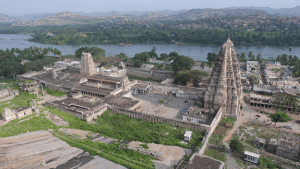
• The Vittala Temple or Vitthala Temple in Hampi is an ancient monument that is well-known for its exceptional architecture and unmatched craftsmanship.
• It is considered to be one of the largest and the most famous structure in Hampi. The temple is located in the north eastern part of Hampi, near the banks of the Tungabhadra River. The renowned Vittala Temple dates back to the 15th century.
• It was built during the reign of King Devaraya II (1422 – 1446 A.D.), one of the rulers of the Vijayanagara Empire. Several portions of the temple were expanded and enhanced during the reign of Krishnadeva Raya (1509 – 1529 A.D.), the most famous ruler of the Vijayanagara dynasty.

• Angkor Wat is a temple complex in Cambodia, resides within the ancient Khmer capital city of Angkor.
• The Guinness World Records considers it as the largest religious structure in the world.
• Originally constructed as a Hindu temple dedicated to the god Vishnu for the Khmer Empire by King Suryavarman II during the 12th century.
• It was gradually transformed into a Buddhist temple towards the end of the century; as such, it is also described as a “Hindu-Buddhist” temple.


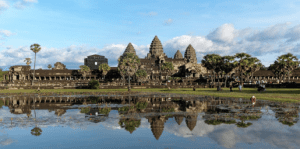 Incorrect
Incorrect
Answer: A
Explanation:
Statement 1 is correct: The Virupaksha temple at Hampi was built by Krishnadeva Raya under Vijayanagara empire in 1509.
Statement 2 is incorrect: The Vijaya Vittala temple having its 56 carved pillars emitting musical notes, is located at Hampi, the capital of the Vijayanagara empire. It is dedicated to Lord Vitthala, an incarnation of Lord Vishnu.
Statement 3 is incorrect: Angkor Vat temple in Cambodia dedicated to Lord Vishnu was built in 1113-1150 by Suryavarman II. It was firstly a Hindu temple but later it went under Buddhist regime.
Additional information:
• Virupaksha Temple is located in Hampi in the Vijayanagara district of Karnataka, India. It is part of the Group of Monuments at Hampi, designated as a UNESCO World Heritage Site. The temple is dedicated to Sri Virupaksha.
• The temple was built by Lakkan Dandesha, a nayaka (chieftain) under the ruler Deva Raya II also known as Prauda Deva Raya of the Vijayanagara Empire.

• The Vittala Temple or Vitthala Temple in Hampi is an ancient monument that is well-known for its exceptional architecture and unmatched craftsmanship.
• It is considered to be one of the largest and the most famous structure in Hampi. The temple is located in the north eastern part of Hampi, near the banks of the Tungabhadra River. The renowned Vittala Temple dates back to the 15th century.
• It was built during the reign of King Devaraya II (1422 – 1446 A.D.), one of the rulers of the Vijayanagara Empire. Several portions of the temple were expanded and enhanced during the reign of Krishnadeva Raya (1509 – 1529 A.D.), the most famous ruler of the Vijayanagara dynasty.


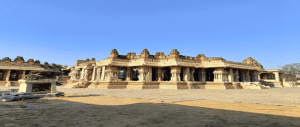
• Angkor Wat is a temple complex in Cambodia, resides within the ancient Khmer capital city of Angkor.
• The Guinness World Records considers it as the largest religious structure in the world.
• Originally constructed as a Hindu temple dedicated to the god Vishnu for the Khmer Empire by King Suryavarman II during the 12th century.
• It was gradually transformed into a Buddhist temple towards the end of the century; as such, it is also described as a “Hindu-Buddhist” temple.



-
Question 4 of 5
4. Question
4. Consider the following statements:
1. Barabar caves were built during the Gupta period.
2. Sanchi stupa does not have mural paintings.
3. Ajanta caves were constructed by the kings of Chalukya dynasty.
4. Pahari paintings belong to Mughal and post-Mughal periods.
How many of the statements given above are correct?Correct
Answer: B
Explanation:
Statement 1 is incorrect: Barabar caves built during 3rd century BCE belonged to the period of Ashoka and his son Dasaratha.
Statement 2 is correct: The Sanchi stupa does not have mural paintings.
Statement 3 is incorrect: Ajanta caves were constructed by the Rashtrakutas and Satvahanas.
Statement 4 is correct: Pahari paintings belong to Mughal and post-Mughal periods.
Additional information:
• The Barabar Hill Caves are the oldest surviving rock-cut caves in India, dating from the Maurya Empire (322–185 BCE), some with Ashokan inscriptions, located in the Makhdumpur region of Jehanabad district, Bihar, India, 24 km (15 mi) north of Gaya.
• The caves were used by ascetics from the Ajivika sect, founded by Makkhali Gosala, a contemporary of Gautama Buddha, the founder of Buddhism, and of Mahavira, the last and 24th Tirthankara of Jainism.
• The Ajivikas had many similarities with Buddhism as well as Jainism. Also present at the site are several rock-cut Buddhist and Hindu sculptures and inscriptions from later periods.


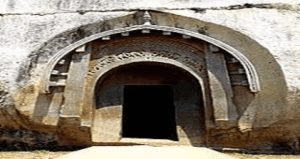
• Sanchi Stupa is a Buddhist complex, famous for its Great Stupa, on a hilltop at Sanchi Town in Raisen District of the State of Madhya Pradesh, India.
• It is located, about 23 kilometers from Raisen town, district headquarter and 46 kilometres north-east of Bhopal, capital of Madhya Pradesh.
• The Great Stupa at Sanchi is one of the oldest stone structures in India, and an important monument of Indian Architecture.
• It was originally commissioned by the Mauryan emperor Ashoka the Great in the 3rd century BCE. Its nucleus was a simple hemispherical brick structure built over the relics of the Buddha.


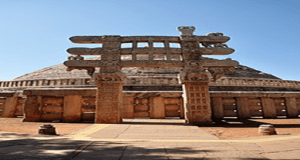
• The Ajanta Caves are 29 rock-cut Buddhist cave monuments dating from the second century BCE to about 480 CE in the Aurangabad District of Maharashtra state in India. Ajanta Caves are a UNESCO World Heritage Site.
• Universally regarded as masterpieces of Buddhist religious art, the caves include paintings and rock-cut sculptures described as among the finest surviving examples of ancient Indian art, particularly expressive paintings that present emotions through gesture, pose and form.


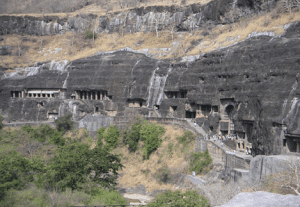
• The Pahari school developed and flourished during 17th-19th centuries stretching from Jammu to Garhwal, in the sub-Himalayan India, through Himachal Pradesh.
• The central theme of Pahari painting is depiction of eternal love of Hindu deities Radha and Krishna.
• A distinct lyricism, spontaneous rhythm, softness, minute intricate details of composition, and intense perception and portrayal of human emotions and physical features distinguish the Pahari miniatures from the other miniature schools like Deccan, Mughal and Rajasthani-Rajput.


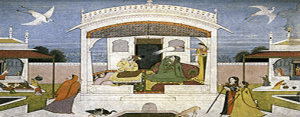 Incorrect
Incorrect
Answer: B
Explanation:
Statement 1 is incorrect: Barabar caves built during 3rd century BCE belonged to the period of Ashoka and his son Dasaratha.
Statement 2 is correct: The Sanchi stupa does not have mural paintings.
Statement 3 is incorrect: Ajanta caves were constructed by the Rashtrakutas and Satvahanas.
Statement 4 is correct: Pahari paintings belong to Mughal and post-Mughal periods.
Additional information:
• The Barabar Hill Caves are the oldest surviving rock-cut caves in India, dating from the Maurya Empire (322–185 BCE), some with Ashokan inscriptions, located in the Makhdumpur region of Jehanabad district, Bihar, India, 24 km (15 mi) north of Gaya.
• The caves were used by ascetics from the Ajivika sect, founded by Makkhali Gosala, a contemporary of Gautama Buddha, the founder of Buddhism, and of Mahavira, the last and 24th Tirthankara of Jainism.
• The Ajivikas had many similarities with Buddhism as well as Jainism. Also present at the site are several rock-cut Buddhist and Hindu sculptures and inscriptions from later periods.



• Sanchi Stupa is a Buddhist complex, famous for its Great Stupa, on a hilltop at Sanchi Town in Raisen District of the State of Madhya Pradesh, India.
• It is located, about 23 kilometers from Raisen town, district headquarter and 46 kilometres north-east of Bhopal, capital of Madhya Pradesh.
• The Great Stupa at Sanchi is one of the oldest stone structures in India, and an important monument of Indian Architecture.
• It was originally commissioned by the Mauryan emperor Ashoka the Great in the 3rd century BCE. Its nucleus was a simple hemispherical brick structure built over the relics of the Buddha.



• The Ajanta Caves are 29 rock-cut Buddhist cave monuments dating from the second century BCE to about 480 CE in the Aurangabad District of Maharashtra state in India. Ajanta Caves are a UNESCO World Heritage Site.
• Universally regarded as masterpieces of Buddhist religious art, the caves include paintings and rock-cut sculptures described as among the finest surviving examples of ancient Indian art, particularly expressive paintings that present emotions through gesture, pose and form.



• The Pahari school developed and flourished during 17th-19th centuries stretching from Jammu to Garhwal, in the sub-Himalayan India, through Himachal Pradesh.
• The central theme of Pahari painting is depiction of eternal love of Hindu deities Radha and Krishna.
• A distinct lyricism, spontaneous rhythm, softness, minute intricate details of composition, and intense perception and portrayal of human emotions and physical features distinguish the Pahari miniatures from the other miniature schools like Deccan, Mughal and Rajasthani-Rajput.



-
Question 5 of 5
5. Question
5. Consider the following pairs:
Literature Texts – Authors
1. Rasaratna Samuccaya – Brahmagupta
2. Brihat Samhita – Varahamihir
3. Siddhanta Shiromani – Nagarjuna
How many of the pairs given above are correctly matched?Correct
Answer: A
Explanation:
Given below is the correctly matched pairs:
Literature Texts – Authors
1. Rasaratna Samuccaya – Vagbhaṭa
2. Brihat Samhita – Varahamihir
3. Siddhanta Shiromani – Bhaskara II
Additional information:
• Rasaratna Samuchaya: Rasaratna Samuccaya is an Indian Sanskrit treatise on alchemy. The text is dated between 13th to 16th century CE. The text contains detailed descriptions of various complex metallurgical processes, as well as descriptions of how to set up and equip a laboratory and other topics concerning Indian alchemy.
• Brihat Samhita: Brihat-saṃhita is a 6th-century Sanskrit-language encyclopedia compiled by Varahamihira in present-day Ujjain, India. Besides the author’s area of expertise—astrology and astronomy—the work contains a wide variety of other topics. The contents of the text fall into two major categories: anga and upanga. The anga discusses divination based on planets, asterisms, and zodiac signs. The upanga discusses a wide variety of other topics, as listed above. Varahamihira does not discuss several traditional topics which he considers legendary and unscientific.
• Siddhanta Shiromani: Siddhanta Shiromani is the major treatise of Indian mathematician Bhaskara II. He wrote the Siddhanta Shiromani in 1150 when he was 36 years old. The work is composed in Sanskrit Language in 1450 verses.
1. Lilavati: It is the first volume of the Siddhanta Shiromani. It contains thirteen chapters, 278 verses, mainly arithmetic and measurement.
2. Bijaganita: It is the second volume of Siddhanta Shiromani. It is divided into six parts, contains 213 verses, and is devoted to algebra.Incorrect
Answer: A
Explanation:
Given below is the correctly matched pairs:
Literature Texts – Authors
1. Rasaratna Samuccaya – Vagbhaṭa
2. Brihat Samhita – Varahamihir
3. Siddhanta Shiromani – Bhaskara II
Additional information:
• Rasaratna Samuchaya: Rasaratna Samuccaya is an Indian Sanskrit treatise on alchemy. The text is dated between 13th to 16th century CE. The text contains detailed descriptions of various complex metallurgical processes, as well as descriptions of how to set up and equip a laboratory and other topics concerning Indian alchemy.
• Brihat Samhita: Brihat-saṃhita is a 6th-century Sanskrit-language encyclopedia compiled by Varahamihira in present-day Ujjain, India. Besides the author’s area of expertise—astrology and astronomy—the work contains a wide variety of other topics. The contents of the text fall into two major categories: anga and upanga. The anga discusses divination based on planets, asterisms, and zodiac signs. The upanga discusses a wide variety of other topics, as listed above. Varahamihira does not discuss several traditional topics which he considers legendary and unscientific.
• Siddhanta Shiromani: Siddhanta Shiromani is the major treatise of Indian mathematician Bhaskara II. He wrote the Siddhanta Shiromani in 1150 when he was 36 years old. The work is composed in Sanskrit Language in 1450 verses.
1. Lilavati: It is the first volume of the Siddhanta Shiromani. It contains thirteen chapters, 278 verses, mainly arithmetic and measurement.
2. Bijaganita: It is the second volume of Siddhanta Shiromani. It is divided into six parts, contains 213 verses, and is devoted to algebra.

